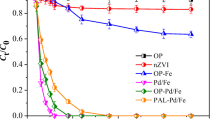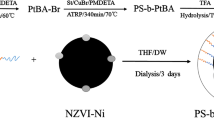Abstract
2,2′,4,4′-Tretrabromodiphenyl ether (BDE47) is known as a typical polybrominated diphenyl ethers (PBDEs) due to its high environmental abundance, ecological toxicity, and bioaccumulation. In this study, the influences of three typical surfactants (CTAB, SDS, and TX-100) on BDE47 solubilization and degradation by the polyanionic cellulose–stabilized Pd/Fe (PAC-Pd/Fe) nanoparticles were investigated. The results showed that BDE47 solubilities increased linearly when surfactant concentrations were above their critical micelle concentrations (CMCs), and the solubilization capacities of surfactants for BDE47 followed the order of TX-100 > CTAB > SDS. The appropriate dosages of surfactants were favorable for BDE47 degradation due to enhancing solubilization and accelerating mass transfer, while excessive surfactants inhibited BDE47 degradation due to excessive and thicker micelles formed, but still higher than no surfactant. The influences of various factors (PAC-Pd/Fe nanoparticle dosage, solution pH, and temperature) on BDE47 degradation in TX-100 solution were also tested. The results showed that BDE47 degradation followed the pseudo first-order kinetics model. The degradation rates of BDE47 increased as PAC-Pd/Fe nanoparticle dosage and temperature increased. Weak acidic condition (pH 5.5) was favorable for BDE47 degradation with 96.8% BDE47 was removed within 7.5 min, while alkaline condition (9.0) was not conducive to the degradation of BDE47. The degradation of BDE47 by PAC-Pd/Fe nanoparticles was a catalytic reductive debromination process via active H-species attack, wherein the sequential debromination was the dominant reaction. This study suggests that in the presence of moderate surfactant, PAC-Pd/Fe nanoparticles may be potentially employed to eliminate BDE47 in contaminated water.







Similar content being viewed by others
References
Bi XH, Qu WY, Sheng GY, Zhang W, Mai BX, Chen DJ, Yu L, Fu JM (2006) Polybrominated diphenyl ethers in South China maternal and fetal blood and breast milk. Environ Pollut 144:1024–1030
Boucher BA, Ennis JK, Tsirlin D, Harris SA (2017) A global database of polybrominated diphenyl ether flame retardant congeners in foods and supplements. J Food Compos Anal 69:171–188
Chan AF, Evans DF, Cussler EL (1976) Explaining solubilization kinetics. AICHE J 38:1006–1012
Darnerud PO (2003) Toxic effects of brominated flame retardants in man and in wildlife. Environ Int 29:841–853
Eriksson J, Green N, Marsh G, Bergman A (2004) Photochemical decomposition of 15 polybrominated diphenyl ether congeners in methanol/water. Environ Sci Technol 38:3119–3125
Fang ZQ, Qiu XH, Chen JH, Qiu XQ (2011a) Degradation of the polybrominated diphenyl ethers by nanoscale zero-valent metallic particles prepared from steel pickling waste liquor. Desalination 267:34–41
Fang ZQ, Qiu XH, Chen JH, Qiu XQ (2011b) Debromination of polybrominated diphenyl ethers by Ni/Fe bimetallic nanoparticles: influencing factors, kinetics, and mechanism. J Hazard Mater 185:958–969
Fu RB, Zhen X, Lin P, Bi DS (2016) Removal of polybrominated diphenyl ethers by biomass carbon-supported nanoscale zerovalent iron particles: influencing factors, kinetics, and mechanism. Environ Sci Pollut Res 23:23983–23993
Ge W, Mou YN, Chai C, Zhang Y, Wang JY, Ju T, Jiang T, Xia B (2018) Polybrominated diphenyl ethers in the dissolved and suspended phases of seawater from Sanggou Bay, East China. Chemosphere 203:253–262
Harendra S, Vipulanandan C (2011) Effects of surfactants on solubilization of serchloroethylene (PCE) and trichloroethylene (TCE). Ind Eng Chem Res 50:5831–5837
He JZ, Robrock KR, Alvarez-Cohen L (2006) Microbial reductive debromination of polybrominated diphenyl ethers (PBDEs). Environ Sci Technol 40(14):4429–4434
Huang KB, Lu GN, Lian WJ, Xu YF, Wang R, Tang T, Tao XQ, Yi XY, Dang Z, Yin H (2017a) Photodegradation of 4,4’-dibrominated diphenyl ether in TritonX-100 micellar solution. Chemosphere 180:423–429
Huang GF, Wang MM, Hu YY, Lv SH, Li CF (2017b) Synthesis, characterization, and debromination reactivity of cellulose-stabilized Pd/Fe nanoparticles for 2,2',4,4'-tretrabromodiphenyl ether. PLoS One 12(3):1–17
Huang GF, Wang MM, Hu YY, Cheng JH, Lv SH, Yang K (2018) Reductive degradation of 2,2’,4,4’-tretrabromodiphenyl ether with PAC-Pd/Fe nanoparticles: effects of Pd loading, initial pH and HA, and degradation pathway. Chem Eng J 334:1252–1259
Kim YM, Nam IH, Murugesan K, Schmidt S, Crowley DE, Chang YS (2007) Biodegradation of diphenyl ether and transformation of selected brominated congeners by Sphingomonas sp. PH-07. Appl Microbiol Biotechnol 77(1):187–194
Kim EJ, Kim JH, Bokare V, Chang YS (2014) Predicting reductive debromination of polybrominated diphenyl ethers by nanoscale zerovalent iron and its implications for environmental risk assessment. Sci Total Environ 470-471:1553–1557
Li JL, Chen B-H (2002) Solubilization of model polycyclic aromatic hydrocarbons by nonionic surfactants. Chem Eng Sci 57:2825–2835
Li Y, Li XQ, XiaoY WCH, Han DH, Huang WL (2016) Catalytic debromination of tetrabromobisphenol A by Ni/nZVI bimetallic particles. Chem Eng J 284:1242–1250
Li Y, Li XQ, Han DH, Huang WL, Yang C (2017) New insights into the role of Ni loading on the surface structure and the reactivity of nZVI toward tetrabromo- and tetrachlorobisphenol A. Chem Eng J 311:173–182
Liang DW, Yang YH, Xu WW, Peng SK, Lu SF, Xiang Y (2014) Nonionic surfactant greatly enhances the reductive debromination of polybrominated diphenyl ethers by nanoscale zero-valent iron: mechanism and kinetics. J Hazard Mater 278:92–596
Liu ZT, Gu CG, Ye M, Bian YR, Cheng YW, Wang F, Yang XL, Song Y, Jiang X (2015) Debromination of polybrominated diphenyl ethers by attapulgite-supported Fe/Ni bimetallic nanoparticles: influencing factors, kinetics and mechanism. J Hazard Mater 298:328–337
Ma J, Qiu XH, Zhang JL, Duan XL, Zhu T (2012) State of polybrominated diphenyl ethers in China: an overview. Chemosphere 88:769–778
Qu RJ, Li CG, Pan XX, Zeng XL, Liu JQ, Huang QG, Feng JF, Wang ZY (2017) Solid surface-mediated photochemical transformation of decabromodiphenyl ether (BDE-209) in aqueous solution. Water Res 125:114–122
Qu RJ, Li CG, Liu JQ, Xiao RY, Pan XX, Zeng XL, Wang ZY, Wu JC (2018) Hydroxyl radical based photocatalytic degradation of halogenated organic contaminants and paraffin on silica gel. Environ Sci Technol 120:7220–7229
Saito S (1967) Solubilization properties of polymer-surfactant complexes. J Colloid Interface Sci 24:227–234
Santos MSF, Alves A, Madeira LM (2016) Chemical and photochemical degradation of polybrominated diphenyl ethers in liquid systems – a review. Water Res 88:39–59
Sayles GD, You G, Wang MX, Kupferle MJ (1997) DDT, DDD, and DDE dechlorination by zero-valent iron. Environ Sci Technol 31:3448–3454
Shi JQ, Qu RJ, Feng MB, Wang XH, Wang LS, Yang SG, Wang ZY (2015) Oxidative degradation of decabromodiphenyl Ether (BDE 209) by potassium permanganate: reaction pathways, kinetics, and mechanisms assisted by density functional theory calculations. Environ Sci Technol 49:4209–4217
Shih YH, Tai YT (2010) Reaction of decabrominated diphenyl ether by zerovalent iron nanoparticles. Chemosphere 78:1200–1206
Söderstrom G, Sellström U, de Wit CA, Tysklind M (2004) Photolytic debromination of decabromodiphenyl ether (BDE 209). Environ Sci Technol 38:127–132
Sun CY, Zhao D, Chen CC, Ma WH, Zhao JC (2009) TiO2-mediated photocatalytic debromination of decabromodiphenyl ether: kinetics and intermediates. Environ Sci Technol 43:157–162
Tratnyek PG, Scherer MM, Deng BL, Hu SD (2001) Effects of natural organic matter, anthropogenic surfactants, and model quinones on the reduction of contaminants by zero-valent iron. Water Res 35:4435–4443
Tso CP, Shih YH (2017) The influence of carboxymethylcellulose (CMC) on the reactivity of Fe NPs toward decabrominated diphenyl ether: the Ni doping, temperature, pH, and anion effects. J Hazard Mater 322:145–151
USEPA (2010) An exposure assessment of polybrominated diphenyl ethers. https://cfpub.epa.gov/ncea/risk/recordisplay.cfm?deid = 210404
Vonderheide AP, Mueller KE, Meija J, Welsh GL (2008) Polybrominated diphenyl ethers: causes for concern and knowledge gaps regarding environmental distribution, fate and toxicity. Sci Total Environ 400:425–436
Wang XY, Lan L, Alvarez PJJ, Fang L, Liu KQ (2015) Synthesis and characterization of green agents coated Pd/Fe bimetallic nanoparticles. J Taiwan Inst Chem Eng 50:297–305
Wang R, Lu GN, Lin HZ, Huang KB, Tang T, Xue XL, Yang XJ, Yin H, Dang Z (2017) Relative roles of H-atom transfer and electron transfer in the debromination of polybrominated diphenyl ethers by palladized nanoscale zerovalent iron. Environ Pollut 222:331–337
Wang R, Tang T, Lu GN, Huang KB, Yin H, Lin Z, Wu FC, Dang Z (2018) Rapid debromination of polybrominated diphenyl ethers (PBDEs) by zero valent metal and bimetals: mechanisms and pathways assisted by density function theory calculation. Environ Pollut 240:745–753
Wang R, Tang T, Lu GN, Zheng ZQ, Huang KB, Li HF, Tao XQ, Yin H, Shi ZQ, Lin Z, Wu FC, Dang Z (2019) Mechanisms and pathways of debromination of polybrominated diphenyl ethers (PBDEs) in various nano-zerovalent iron-based bimetallic systems. Environ Pollut 245:780–788
Wei JJ, Xu XH, Liu Y, Wang DH (2006) Catalytic hydrodechlorination of 2,4-dichlorophenol over nanoscale Pd/Fe: reaction pathway and some experimental parameters. Water Res 40:348–354
Yang XJ, Lu GN, Wang R, Guo CL, Zhang HL, Dang Z (2015) Solubilization of 4,4'-dibromodiphenyl ether under combined TX-100 and cosolvents. Environ Sci Pollut Res 22:3856–3864
Yang XJ, Lu GN, Huang KB, Wang R, Duan XC, Yang C, Yin H, Dang Z (2016) Synergistic solubilization of low-brominated diphenyl ether mixtures in nonionic surfactant micelles. J Mol Liq 223:252–260
Zhang M, He F, Zhao DY, Hao XD (2011) Degradation of soil-sorbed trichloroethylene by stabilized zero valent iron nanoparticles: effects of sorption, surfactants, and natural organic matter. Water Res 45:2401–2414
Zheng ZQ, Lu GN, Wang R, Huang KB, Tao XQ, Yang YL, Zou MY, Xie YY, Yin H, Shi ZQ, Dang Z (2019) Effects of surfactant on the degradation of 2,2′,4,4′-tetrabromodiphenyl ether (BDE-47) by nanoscale Ag/Fe particles: kinetics, mechanisms and intermediates. Environ Pollut 245:780–788
Zhu BW, Lim TT, Feng J (2008) Influences of amphiphiles on dechlorination of a trichlorobenzene by nanoscale Pd/Fe: adsorption, reaction kinetics, and interfacial Interactions. Environ Sci Technol 42:4513–4519
Zhuang Y, Ahn S, Luthy RG (2010) Debromination of polybrominated diphenyl ethers by nanoscale zerovalent iron: pathways, kinetics, and reactivity. Environ Sci Technol 44:8236–8242
Zhuang Y, Ahn S, Seyfferth AL, Yoko MS, Fendorf S, Luthy RG (2011) Dehalogenation of polybrominated diphenyl ethers and polychlorinated biphenyl by bimetallic, impregnated, and nanoscale zerovalent iron. Environ Sci Technol 45:4896–4903
Zhuang Y, Jin L, Luthy RG (2012) Kinetics and pathways for the debromination of polybrominated diphenyl ethers by bimetallic and nanoscale zerovalent iron: effects of particle properties and catalyst. Chemosphere 89(4):426–432
Funding
This study was financially supported by the Weifang University of Science and Technology Fund (nos. 2018KJBS001, 2018RC003, 2018KJYB10), the Dongguan Social Science and Technology Development General Project (no. 20185071401502), the Shandong Natural Science Fund (no. ZR2019MEM046), and Weifang Science and Technology Development Plan Project (no. 2019GX072).
Author information
Authors and Affiliations
Corresponding author
Additional information
Responsible editor: Bingcai Pan
Publisher’s note
Springer Nature remains neutral with regard to jurisdictional claims in published maps and institutional affiliations.
Electronic supplementary material
ESM 1
(DOCX 345 kb)
Rights and permissions
About this article
Cite this article
Li, H., Huang, G. & Wang, M. Enhanced solubilization and reductive degradation of 2,2′,4,4′- tretrabromodiphenyl ether by PAC-Pd/Fe nanoparticles in the presence of surfactant. Environ Sci Pollut Res 27, 5085–5096 (2020). https://doi.org/10.1007/s11356-019-06627-4
Received:
Accepted:
Published:
Issue Date:
DOI: https://doi.org/10.1007/s11356-019-06627-4




